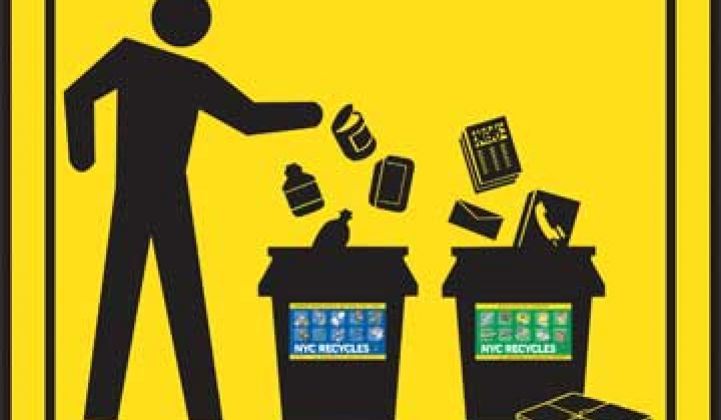Last week, I stood in front of a trio of trash bins located near an auditorium entrance at Pacific Gas & Electric in San Francisco. I had just finished my coffee and tossed the plastic top and compostable cup into a recycling bin. My food scraps went into another container. I threw a small waxy candy wrapper from my purse into the trash.
As a New Yorker, I am well aware of San Francisco’s superior recycling efforts as compared to the Big Apple. Deli containers, ubiquitous throughout New York, cannot be recycled. National coffee-pusher Starbucks has been developing a compostable cup for years, although there are available solutions in the marketplace. Don’t even get me started on how uneducated New Yorkers are on electronics recycling (residents could toss TVs in the trash until recently). This weekend, as I landed back at JFK, others were talking about the topic. The New York Times wrote about New York City’s lack of commitment to recycling, despite the aggressive PlaNYC 2030 initiative, which tackles nearly every sustainability issue in the city.
The issue, however, is not just New York versus San Francisco. Recycling is often lauded as a great success in sustainability here in America, but success is variable. I hear the same refrain repeated at cleantech and sustainability conferences: While your parent or grandparent might balk at separating recyclables, young kids can’t imagine not doing it. That said, speakers often say that energy awareness is right around the corner.
A closer look shows that this is not always true. Recycling rates, overall, are far higher today than they were in the 1970s. But many recycling rates have been flatlined for nearly a decade -- and not just during recent recession. It took until 1990 for recovery rates for recycling to get beyond 15 percent, according to the U.S. Environmental Protection Agency. The volume of municipal waste is rising faster than the rate of recycling participation.
In 2009, nearly 34 percent of the municipal solid waste that was generated was recycled. However, curbside recycling is also nearly flat since 2002, and community composting is down over the same period.
Outside of cities like San Francisco and Los Angeles, recycling is largely an enigma. (In New York, for instance, the NYC Sanitation website tells you to recycle plastic “jugs,” rather than specifying which plastic numbers can be recycled.) The rules change often in New York City, and from town to town across the country. In many places, it is still cheaper to send it to the landfill than to recycle. According to a recent report by Siemens, only 14 of 27 U.S. and Canadian cities have comprehensive waste reduction strategies, compared to all European cities with similar income levels and demographics.
The New York Times did point to some successes, like the Green Restaurant Association, which has about 80 members in New York that can earn ratings for efforts like reducing energy consumption and composting food waste. The city is also looking into larger methods, like pay-as-you-throw, which has been deployed successfully in Seoul.
Recycling is not a failure in the U.S., but it is far from an example of environmental awakening. In most cities where recycling rates are high, there is a financial burden for those that don’t comply. That could be the best lesson of all from recycling to apply to other sustainability issues, including energy efficiency. It’s not a warm, fuzzy habit that the next generation will inherently embrace. Rather, it is solid policy and adequate infrastructure accompanied by enforcement that will bring sustainability practices out of niche areas and into the mainstream.



